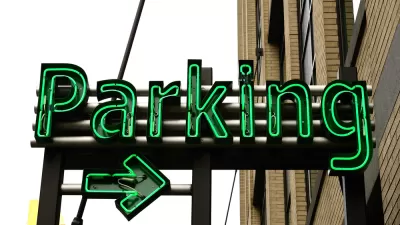The annual conference of the North Carolina chapter of the American Planning Conference brought together over 500 planners looking for lessons in planning for growth. The conference site of Raleigh provided a case study for a flourishing region.

Earlier this month, Raleigh, North Carolina provided the setting for the state's annual professional conference. The message: Plan for growth, manage it, and reap the rewards.
North Carolina's annual professional planning conference is held each fall, and following this year's near-record breaking attendance during the American Planning Association's (APA) national conference in Seattle, I've been curious whether attendance would be similarly strong at North Carolina's statewide professional planning event, the NC APA annual conference.
State APA chapter conferences are one of the more significant local planning events, and attendance can help gauge several things: how well the economy is doing, the level of interest in (and convenience of) the conference location, and the strength of departmental training budgets. This year's attendance topped 550, which is among the highest in chapter history (total membership includes approximately 1,400 professional and citizen planners). Whether or not those attendance numbers confirm that we are in a new era in planning or, possibly, just better economic times, the turnout is exciting. North Carolina is now the 9th largest state, with 10 million residents. It recently surpassed Michigan for the #9 slot, and added almost 100,000 residents in 2013. Some point to job creation, lower taxes, and quality of life as major reasons for the population surge.
Issues and opportunities facing North Carolina are challenging, exciting, and familiar to planners across the country. Some topics I have covered in previous posts, including wind energy, the environment, transportation, urban design, development regulation, and the announcement of upcoming Google Fiber service in the Triangle (Raleigh-Durham-Chapel Hill).
The tag line for this year's state conference is Growing Stronger Together, which seems quite suitable. Raleigh, this year's conference host city, showed us first-hand how proactive planning, responsive regulation, and strategic, timely investments generate desirable growth in the downtown core and neighborhoods. The conference venue itself—the convention center—helped launch the city's downtown revitalization ten years ago, and the urban core has continued to become a more walkable, attractive, and productive environment. Several planning lessons are discovered just taking a step outside the conference center and crossing Salisbury Street. Then, standing in the middle of Fayetteville Street and looking down toward the capital building, one is surrounding by concrete results of city planning.

Planners are the best tour guides for other planners because they have the insights to our wonky questions. Here's what I picked up during the Downtown Raleigh walking tour, which was led by Raleigh planning staff:
- Raleigh is one of only a handful of U.S. cities planned as a state capital city (similar to Indianapolis) and was early to adopt and implement key planning mechanisms, like its zoning regulations, housing authority, and neighborhood plans.
- Downtown Raleigh suffered mid-century decline familiar to many historic urban areas: suburbanization, retail and manufacturing flight, and general disinvestment in the downtown made it an unwelcoming place.
- The current era of downtown revitalization started ten years ago with a conscious effort to bring the downtown back, including supportive policy, regulation, infrastructure investments, and economic development initiatives.
- Building the convention center was an initial success, and helped anchor the southern end of downtown, opposite the state capital plaza.
- Downtown is fortunate that it is not bisected or encircled by a major transportation thoroughfare, and yet the pleasing, seamless transition to single family residential neighborhoods sometimes translates to major land use compatibility issues and concerns from surrounding neighborhoods.
- Economic development is intentional, despite today's favorable economy and uptick in new construction. For example, Raleigh lured software firmRed Hat, whose millennial clientele was looking for a funky downtown location, not an office park (you know the one I mean). Red Hat chose Raleigh, has invested in the downtown, and helped attract allied firms.
- Raleigh is clever in its operations: Design competitions and a multi-functional in-house staff helps the city imagine, communicate, and secure funding for high-profile redevelopment like the upcoming improvements at Moore Square.
- More building will happen: The Warehouse District will be the next frontier of downtown development, and it will probably unrecognizable in a few years. The city cannot build hotel rooms fast enough.

"Good development starts with good planning." Greg Hatem, Empire Properties Exec and restaurateur, gives an impromptu pep talk during the downtown walking tour at the North Carolina APA conference. Empire manages 41 properties, with three new developments in the pipeline. (Credit: Pete Sullivan)
Despite all this excitement, the walking tour didn't hold a captive audience for everyone. At one point an attendee suddenly left the group and bee-lined it for the The Pit on Davie Street and could be heard muttering, "See ya later, I'm breaking off for this place." Having tasted The Pit in Durham, I couldn't blame him.
Raleigh is making some good decisions and enjoying success, so I asked the Raleigh staff team what they wish they did have. The answer: A water feature.
Good planning means celebrating what you already have, whether it's a scenic vista, leafy trees, or a thriving arts scene. Raleigh doesn't have the water, but in a region of innovation, I wouldn't be surprised to see something bubble up anyway. Maybe we'll be hearing how they did it next year at the 2016 state conference in Asheville, over a cold beer.

Pete Sullivan, AICP, is a Senior Associate with Clarion Associates in Chapel Hill, North Carolina, where he specializes in land use regulation and comprehensive planning.

Trump Administration Could Effectively End Housing Voucher Program
Federal officials are eyeing major cuts to the Section 8 program that helps millions of low-income households pay rent.

Planetizen Federal Action Tracker
A weekly monitor of how Trump’s orders and actions are impacting planners and planning in America.

The 120 Year Old Tiny Home Villages That Sheltered San Francisco’s Earthquake Refugees
More than a century ago, San Francisco mobilized to house thousands of residents displaced by the 1906 earthquake. Could their strategy offer a model for the present?

HSR Reaches Key Settlement in Northern California City
The state’s high-speed rail authority reached an agreement with Millbrae, a key city on the train’s proposed route to San Francisco.

Washington State Legislature Passes Parking Reform Bill
A bill that would limit parking requirements for new developments is headed to the governor’s desk.

Missouri Law Would Ban Protections for Housing Voucher Users
A state law seeks to overturn source-of-income discrimination bans passed by several Missouri cities.
Urban Design for Planners 1: Software Tools
This six-course series explores essential urban design concepts using open source software and equips planners with the tools they need to participate fully in the urban design process.
Planning for Universal Design
Learn the tools for implementing Universal Design in planning regulations.
Ada County Highway District
Clanton & Associates, Inc.
Jessamine County Fiscal Court
Institute for Housing and Urban Development Studies (IHS)
City of Grandview
Harvard GSD Executive Education
Toledo-Lucas County Plan Commissions
Salt Lake City
NYU Wagner Graduate School of Public Service





























